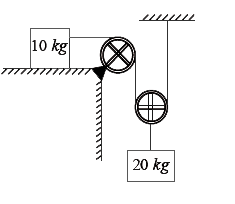The smallest mass is that of ………….. Of the order of …………… kg.
The correct Answer is:electron ;10−30
To solve the question regarding the smallest mass and its order, we can follow these steps:
Step 1: Identify the smallest particle
The smallest known particle in terms of mass is the electron.
Step 2: Find the mass of the electron
The mass of an electron is approximately 9.1×10−31 kg.
Step 3: Express the mass in a suitable form
To express the mass in a more manageable form, we can rewrite 9.1×10−31 kg as 0.91×10−30 kg.
Step 4: Determine the order of the mass
The order of the mass of the electron can be determined by looking at the exponent in the scientific notation. In this case, the order is 10−30 kg.
Final Answer
Thus, the smallest mass is that of the electron, of the order of 10−30 kg.
---
The smallest known particle in terms of mass is the electron.
The mass of an electron is approximately 9.1×10−31 kg.
To express the mass in a more manageable form, we can rewrite 9.1×10−31 kg as 0.91×10−30 kg.
The order of the mass of the electron can be determined by looking at the exponent in the scientific notation. In this case, the order is 10−30 kg.
Thus, the smallest mass is that of the electron, of the order of 10−30 kg.
Topper's Solved these Questions
- PHYSICAL WORLD AND MEASUREMENTBOOK - PRADEEPCHAPTER - PHYSICAL WORLD AND MEASUREMENTEXERCISE - Multiple choice questions - 1 NCRT
18 Videos
- PHYSICAL WORLD AND MEASUREMENTBOOK - PRADEEPCHAPTER - PHYSICAL WORLD AND MEASUREMENTEXERCISE - Competiton Focus Jee Medical Entrance I. Multiple choice Questions
63 Videos
- PHYSICAL WORLD AND MEASUREMENTBOOK - PRADEEPCHAPTER - PHYSICAL WORLD AND MEASUREMENTEXERCISE - Test Your Grip
50 Videos
- OSCILLATIONS AND WAVESBOOK - PRADEEPCHAPTER - OSCILLATIONS AND WAVESEXERCISE - multiple choice Questions
13 Videos
- PROPERTIES OF BULK MATTERBOOK - PRADEEPCHAPTER - PROPERTIES OF BULK MATTEREXERCISE - Multiple choice questions
7 Videos
Similar Questions
Knowledge Check
Assume that the nuclear mass is of the order of 10−27kg and the nuclear radius is of the order of 1015m. The nuclear density is of the order of
A102Kg/m3B1010Kg/m3C1017Kg/m3D1031Kg/m3The smallest number that must be added to 803642 in order to obtain a multiple of 11 is
Aa) 1Bb) 4Cc) 7Dd) 9The smallest number which must be added to 803642 in order to obtain a multiple of 9 is :
A1B2C3D4
Two masses of 10 kg and 20 kg are connected with an inextensible string passing over two smooth pulleys as shown in the figure. The acceleration of 20 kg mass will be :

View SolutionTwo bodies of masses 5 kg and 20 kg are separated by a distance of 300 m. A body of mass 1 kg is placed between the two masses in a straight line. If the forces of attraction due to the two masses on the body of 1 kg mass are the same, the distance between the 1 kg body and the 5 kg body is ____________
View SolutionTwo bodies of masses 5 kg and 20 kg are separated by a distance of 300 m. A body of mass 1 kg is placed between the two masses in a straight line. If the forces of attraction due to the two masses on the body of 1 kg mass are the same, the distance between the 1 kg body and the 5 kg body is ____________
View SolutionA 3kg mass and 4kg mass are placed on X and Y axes at a distance of 1 meter from the origin and a 1kg mass is placed at the origin. Then the resultant gravitational force on 1kg mass is
View SolutionA bomb of mass 3 m kg explodes into two pieces of mass m kg and 2 m kg. If the velocity of m kg mass is 16ms−1, the total kinetic energy in the explosion is :
View Solution
